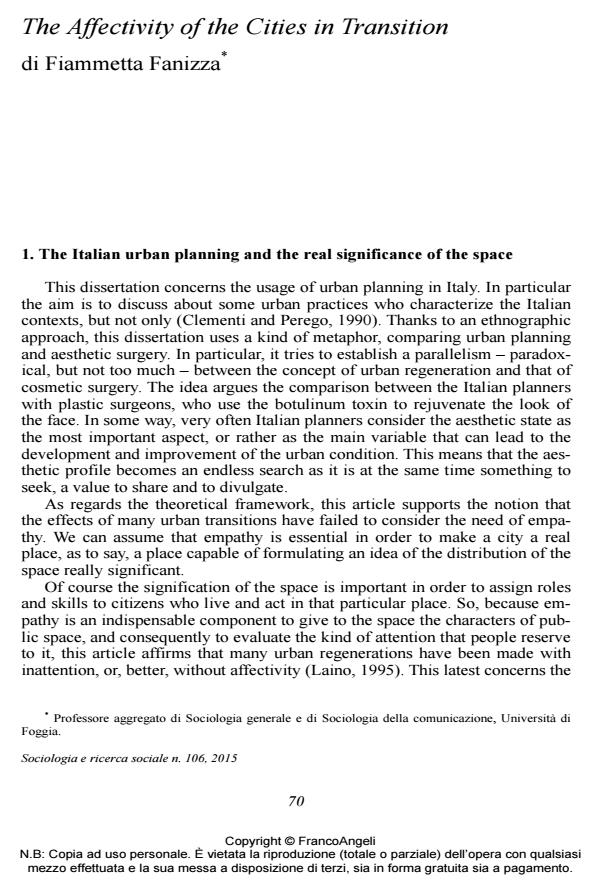The Affectivity of the Cities in Transition
Titolo Rivista SOCIOLOGIA E RICERCA SOCIALE
Autori/Curatori Fiammetta Fanizza
Anno di pubblicazione 2015 Fascicolo 2015/106 Lingua Italiano
Numero pagine 10 P. 70-79 Dimensione file 48 KB
DOI 10.3280/SR2015-106004
Il DOI è il codice a barre della proprietà intellettuale: per saperne di più
clicca qui
Qui sotto puoi vedere in anteprima la prima pagina di questo articolo.
Se questo articolo ti interessa, lo puoi acquistare (e scaricare in formato pdf) seguendo le facili indicazioni per acquistare il download credit. Acquista Download Credits per scaricare questo Articolo in formato PDF

FrancoAngeli è membro della Publishers International Linking Association, Inc (PILA)associazione indipendente e non profit per facilitare (attraverso i servizi tecnologici implementati da CrossRef.org) l’accesso degli studiosi ai contenuti digitali nelle pubblicazioni professionali e scientifiche
During the last few years, several Italian city-planners have considered the concept of urban transition as something aprioristically able to produce new social practices. The aim of this article is to analyze the effects of transition in the metropolitan area of Bari (a large town in Southern Italy) where most of the recent public works have ignored the need for empathy. In particular they have not considered the way to capture the citizens’ imagination which is essential for distribution of affectivity into human relationships as those with public institutions. This thesis takes its cue from the results of recent studies regarding the negative effects on the affective tone produced by the botulinum toxin used in plastic surgery, and argues that public works are performed according to an aesthetic view that does not consider the value of beauty as sociability.;
- F. Bianchini, M. Parkinson (1993), Cultural Policy and Urban Regeneration: The West European Experience, Manchester, Manchester University Press.
- Aa.Vv. (2004), Urban Regeneration, Città di Castello, Alinea.
- R. Alterman, G. Cars (1991), Neighborhood Regeneration: An International Evaluation, London, Mansell.
- G. Amendola (1977), Case, quartiere, rinnovo urbano. Le trasformazioni sociali dello spazio marginale, Bari, Dedalo.
- G. Amendola (1985), Uomini e case, Bari, Dedalo.
- G. Amendola (2010), Tra Dedalo e Icaro. La nuova domanda di città, Roma-Bari, Laterza.
- A. Bertagna (2010), Il controllo dell’indeterminato. Potemkin villages e altri nonluoghi, Macerata, Quodlibet Studio.
- P. Becker-Wegerich, L. Rauch, T. Ruzicka (2011), «Botulinum Toxin A in the Therapy of Mimic Facial Lines», Clinical and Experimental Dermatology
- G. Laino (1999), «Il programma Urban in Italia», Asur, 66, pp. 69-97.
- G. Laino (1995), «La riqualificazione dei quartieri degradati in Europa: le difficoltà di affermazione di un approccio integrato alla riqualificazione», Archivio di studi urbani e regionali, 54, pp. 5-44.
- A. Klingmann (2010), Brandscapes: Architecture in the Experience Economy, Cambridge, Mit Press.
- A.W. Klein (2003), «Complications, Adverse Reactions, and Insights with the Use of Botulinum Toxin», Dermatol. Surg., May, pp. 549-56.
- J.M. Keillor, A.M. Barrett, G.P. Crucian, S. Kortenkamp, K.M. Heilman (2002), Emotional Experience and Perception in the Absence of Facial Feedback, Gainesville, Department of Neurology, College of Medicine, University of Florida.
- C. Jacquier C. (1990), Voyage dans dix quartiers européens en crise, Paris, l’Harmattan. C. Jencks (1988), Architecture today, New York, Harry N. Abrams.
- J. Jacob (1989), The Death and Life of Great American Cities, New York, Vintage Books Edition, Random House.
- R.G. Glogau (2002), «Review of the Use of Botulinum Toxin for Hyperhidrosis and Cosmetic Purposes», The Clinical Journal of Pain, Nov-Dec., pp. 191-7.
- R. Galdini (2008), Reinventare la città. Strategie di rigenerazione urbana in Italia e in Germania, Milano, FrancoAngeli.
- J. Friedrichs, C. Galster, S. Musterd (2003), «Neighbourhood Effects on Social Opportunities: The European and American Research and Policy Context», Housing Studies, XVIII, 6, pp. 797-806.
- F. Fanizza (2015), «Interculturalità e gentrification», Humatitas, 69, pp. 653-60.
- F. Fanizza (a c. di) (2013), La spettacolarizzazione dell’umano e le sue forme, Bari, Progedit.
- J. Donzelot, M.C. Jaillet (2001), La nouvelle question urbaine, Paris, Puca.
- De Franciscis G. (1997), Rigenerazione urbana. Il recupero delle aree dismesse in Europa, Castellamare di Stabia, Eidos.
- A. de Candia, A. Mela, C. Rossignolo, S. Saccomani, A. Toldo (2007), Monitoraggio e valutazione del programma Urban Italia «Venaria unica». Rapporto finale, Torino.
- M. Cremaschi (2003), Progetti di sviluppo del territorio Le azioni integrate locali in Italia e in Europa, Milano, Il Sole24ore.
- M. Cremaschi (a c. di) (1999), Il programma di iniziativa comunitaria Urban. Sei casi di studio, Sottoprogramma Pass, Formez.
- programmazione integrata nelle città italiane”, Ministero dei Lavori pubblici-Inu, Inu Edizioni, Roma, 2 voll..
- L. Contardi, M. Moscato, M. Ricci (1999), “Programmi di riqualificazione urbana: azioni di
- C. Couch, C. Fraser, S. Percy (2008), Urban Regeneration in Europe, Hoboken, John Wiley & Son.
- Commissione europea, Ministero dei lavori pubblici (1999), Il programma Urban in Italia. Un grande laboratorio per la rigenerazione dei quartieri urbani degradati, Roma.
- A. Clementi, F. Perego (a c. di) (1990), Eupolis: la riqualificazione delle città in Europa, Roma-Bari, Laterza.
- A. Carruthers, K. Kiene, J. Carruthers (1996), «Botulinum: A Exotoxin Used in Clinical Dermatology», Journal of American Academy of Dermatology, May, pp. 788-97.
- N. Buck (2001), «Identifying Neighbourhood Effects on Social Exclusion», Urban Studies, XXXVIII, 12, pp. 2251-75 N. Buck, I. Gordon, A. Harding, I. Turok (2005), Changing Cities, Rethinking Competitiveness, Cohesion an Governance, Houndsmills-New York, Palgrave.
- P. Briata (2007), Sul filo della frontiera. Politiche urbane in un quartiere multietnico di Londra, Milano, FrancoAngeli.
- V. Lingua (2007), Riqualificazione urbana alla prova: forme di innovazione e programmi complessi dal quartiere all’area vasta, Firenze, Alinea.
- A. Loos (1982), Spoken into Void: Collected Essays 1897-1900, Cambridge, Mit Press.
Fiammetta Fanizza, The Affectivity of the Cities in Transition in "SOCIOLOGIA E RICERCA SOCIALE " 106/2015, pp 70-79, DOI: 10.3280/SR2015-106004